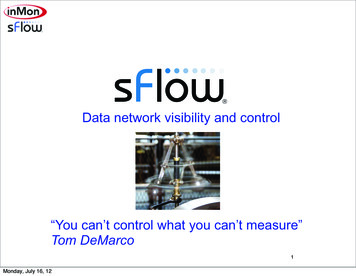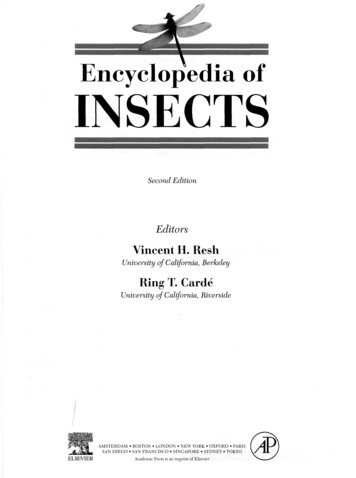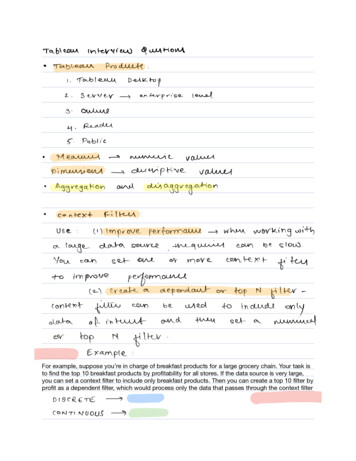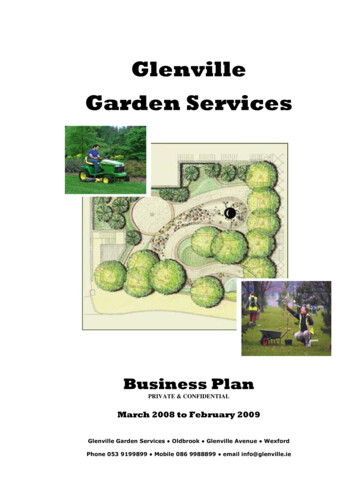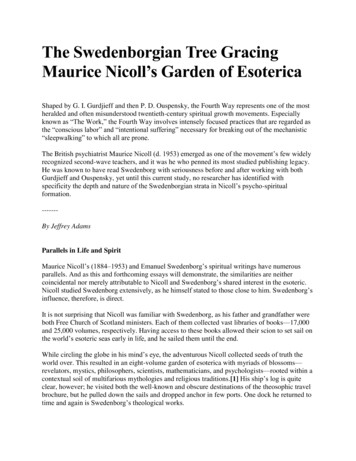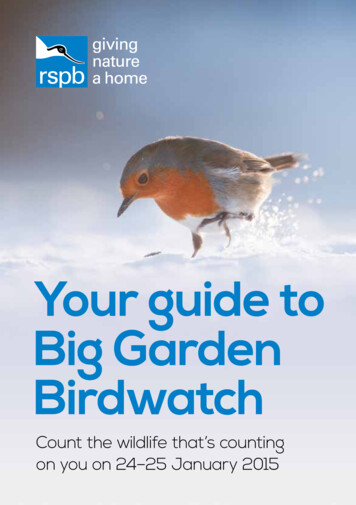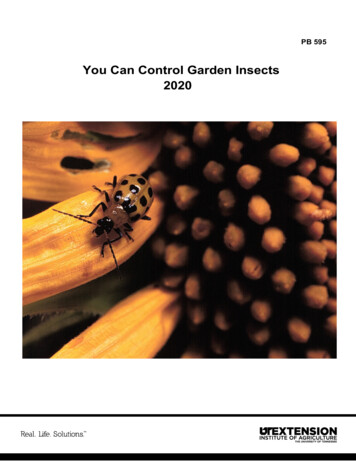
Transcription
PB 595You Can Control Garden Insects2020
Table of ContentsInsect Infestations . 1Insect Reproduction, Growth and Development . 1Soil Insects. 2Seed Corn Maggot . 2Onion Maggot . 3Cabbage Maggot . 3Wireworm . 3White Grub . 3Potato Tuberworm . 3Early-Season Insect Pests . 4Cutworm . 4Thrips . 4Flea Beetle . 4Aphids . 4Lygus Bugs . 5Insect Pests Infesting Plant Foliage, Pods and Fruits . 5Mexican Bean Beetle . 5Stink Bug . 5Whitefly . 5Hornworms (Tobacco and Tomato). 6Leafminer . 6Squash Vine Borer . 6Stalk Borer . 6Blister Beetle. 7Harlequin Bug . 7Squash Bug . 7Colorado Potato Beetle . 7Leafhopper . 8European Corn Borer . 8Fall Armyworm . 8Corn Earworm or Tomato Fruitworm. 8Cowpea Curculio . 9Cucumber Beetles — Spotted Cucumber Beetle . 9Cucumber Beetles — Striped Cucumber Beetle . 9Cabbage Looper . 9Diamondback Moth Caterpillar . 10
Imported Cabbageworm. 10Spider Mites . 10Pickleworm . 10Nonchemical Control of Insects. 10Garden Site Selection. 11Soil Preparation. 11Vigorous Plants . 11Plant Early. 11Diversified Planting . 11Do Not Plant Seed Too Deep . 11Use Physical Barriers . 11Companion Planting . 11Water the Garden . 12Harvest Vegetables . 12Weeds in or Around the Garden Area . 12Use Bacillus thuringiensis. 12Handpicking Some Insects. 12Cut Out the Squash Vine Borer. 12Solarization . 12Repelling Insect Vectors in Tomatoes and Cucurbits . 12Crop Rotation. 12Resistant Varieties . 12Proper Plant Spacing . 12Clean up All Plants . 13Heat . 13Insect Predators, Parasitoids and Disease-Causing Organisms . 13Predators . 13Lady Beetle . 13Ground Beetle . 13Lacewing. 13Praying Mantid . 14Damsel Bug. 14Spider . 14Parasitoids . 14Diseases . 14Chemical Control Insecticide Precautions . 15The Insecticide Label . 15Common Insecticides . 15Chemical Control of Insects. 16
Dusts . 16Sprays . 16The Compressed Air Sprayer . 17Applying an Insecticide to Plants . 17Spraying . 17Using Insecticides Properly to Prevent Pollution . 18Mixing a Garden Spray . 18Applying a Garden Spray. 18Application Rate of Insecticides for Home Gardens. 18Row Applications. 18Safe Handling of Insecticides . 19Fire Ants . 19Slugs and Snails . 20Preplant Insecticides for Wireworms, Fire Ants and Other Soil Insects . 20Organic Pest Management . 20Home Vegetable Garden Insect Control . 21Ways to Minimize Pesticide Use in Gardens . 41Prevent Pest Problems . 41Inspect Regularly . 41Use Alternative Control Methods . 41Pictorial Key of Common Adult Insects on Vegetables . 42Pictorial Key of Common Immature Insect Pests on Vegetables . 44Helpful website ipm.ncsu.edu/AG295/html/index.htmlInsect and Related Pests of VegetablesK. Sorenson and J. Baker [ed.]Prepared by Cathy Cameron Carter and K. Sorenson with collaboration by D. StephanNorth Carolina Cooperative Extension ServiceWe thank the following institutions for providing the black and white images that may have been used in this publication:North Carolina State University Cooperative Extension ServiceUniversity of Maine Cooperative Extension ServiceOhio State University Extension ServiceUniversity of Nebraska Cooperative Extension ServiceNatural Resources CanadaUSDA, ARSCover photo of spotted cucumber beetle by Frank A. Hale.
You CanControl GardenInsectsKaren M. Vail, Professor; Frank A. Hale, Professor; Jennifer Chandler, Research Specialist IIIDepartment of Entomology and Plant PathologyInsect InfestationsInsect infestations reduce yields and lower thequality of harvested garden vegetables. Three to sevengenerations of many insect pests attack gardenvegetables during the growing season. All plant partsmay be injured by insects. Some insects bore intoroots, seeds or stems. Many suck large quantities ofplant sap. Others destroy crops by chewing on thesucculent foliage, stems or fruits. Plant diseases arecarried by certain insects.Safe, effective and economical control measurescan minimize the loss from insects. Control can bemaintained all season by a combination of culturalpractices, mechanical control, biological control andchemical applications. To maintain control, followthese practices, as they apply to the vegetables inyour garden: Anticipate insect pest problems. Remove other vegetation and debris thatharbor insects from vegetable garden beds. Turn under spent plants when the vegetableshave been harvested. Inspect plants regularly for insect infestationsand spray insecticides when needed. Apply insecticidal sprays when the young,most vulnerable stages of insect pests arebeginning to hatch or emerge. Observe use restrictions and avoid applyinginsecticide on garden vegetables within theminimum number of days between last applicationand harvest (pre-harvest interval). Select insecticides that take a short time tocontrol insects during the harvest period thathave a short pre-harvest interval.2020 You Can Control Garden InsectsInsect Reproduction, Growthand DevelopmentHow Insects GrowMost insects develop from an egg and, uponhatching, have a form different from that of the adult.The series of form changes as an insect develops fromegg to adult is called metamorphosis. The younginsect is covered with a more or less firm skin calledthe exoskeleton. As the insect feeds, it grows insidethis skin, but it cannot increase in volume because it isrestricted by its exoskeleton. A new elasticexoskeleton then forms under the old rigidexoskeleton. The old exoskeleton splits along theback and the insect crawls out of its old skin andexpands to its new size. After exposure to air for ashort time, the new exoskeleton becomes hardenedand the insect is ready to resume activity and growsome more. The process of shedding the old skin iscalled molting. Molting occurs several times overvarying periods of time until the final stage is reached.With each molt insects change their form tovarying degrees, depending on the kind ofmetamorphosis that insects may have. Mostvegetable garden insect pests have either gradual(Figure 1) or complete metamorphosis (Figure 2).Examples of gradual or incomplete metamorphosis,in which the very young resemble the adults, includeplant bugs, grasshoppers, stink bugs, squash bugs,aphids and leafhoppers. Examples of pests withcomplete metamorphosis are Mexican bean beetles,cabbage loopers, hornworms, flies, June beetles,cutworms and armyworms.1
Gradual metamorphosis (Figure 1). Generally theseyoung insects resemble the adults. In proportion to therest of the body, the legs and head become relativelysmaller in each instar. This is because the head and legsdo not grow as fast as the rest of the body. In insectsthat are winged, there is also a gradual development ofthe wings with each molt. There are no more molts afterthe fully developed, winged, adult emerges. Not all ofthese insects develop wings. The young are callednymphs. Nymphs and adults inhabit the same placesand eat the same kind of food.eggnymphadultGradual MetamorphosisnymphnymphFigure 1egglarvaComplete metamorphosis (Figure 2). All four stages ofdevelopment —
Safe, effective and economical control measures can minimize the loss from insects. Control can be maintained all season by a combination of cultural practices, mechanical control, biological control and chemical applicati ons. To maintain control, follow these practices, as they apply to
